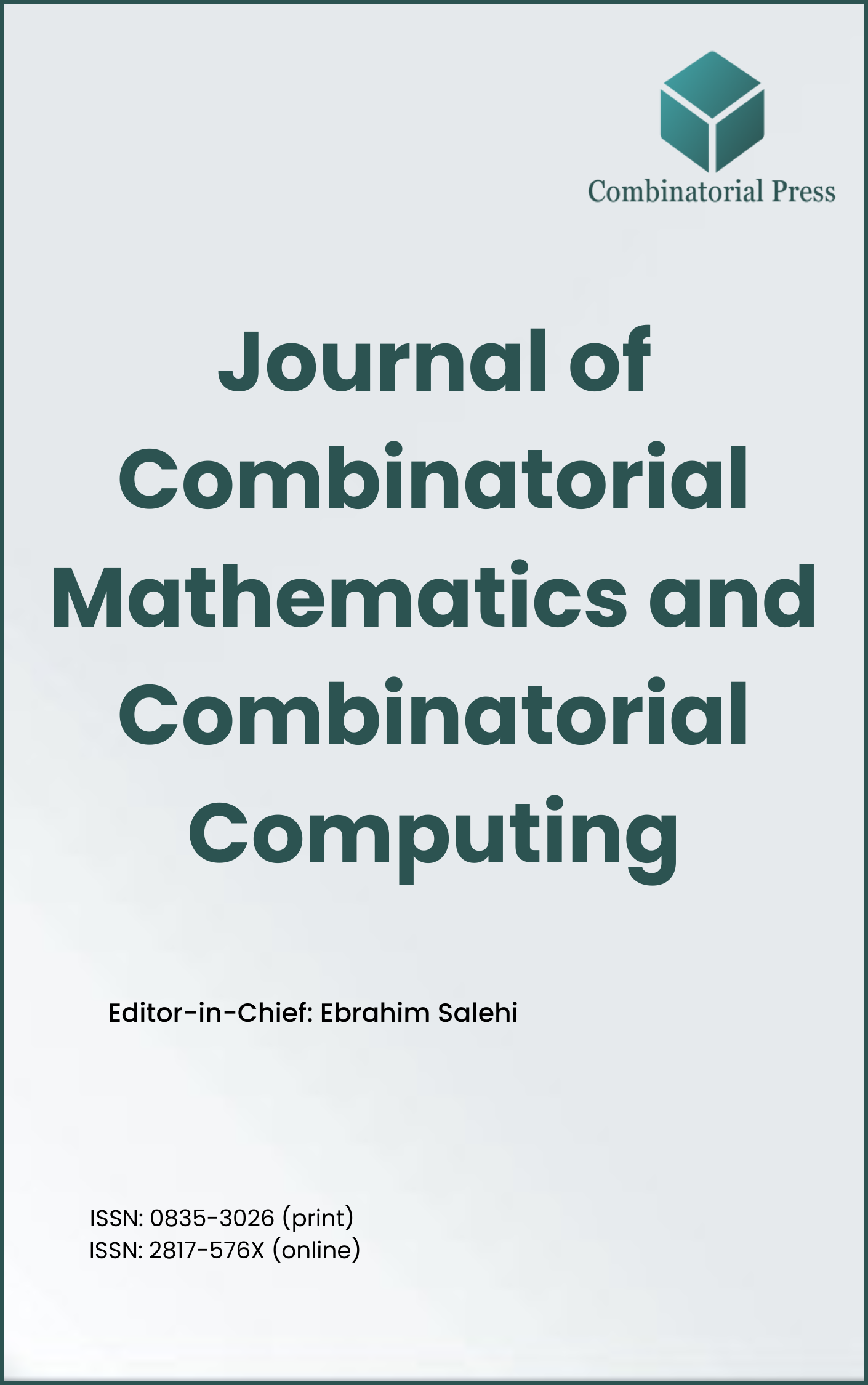
Journal of Combinatorial Mathematics and Combinatorial Computing
ISSN: 0835-3026 (print) 2817-576X (online)
The Journal of Combinatorial Mathematics and Combinatorial Computing (JCMCC) embarked on its publishing journey in April 1987. From 2024 onward, it publishes four volumes per year in March, June, September and December. JCMCC has gained recognition and visibility in the academic community and is indexed in renowned databases such as MathSciNet, Zentralblatt, Engineering Village and Scopus. The scope of the journal includes; Combinatorial Mathematics, Combinatorial Computing, Artificial Intelligence and applications of Artificial Intelligence in various files.
Information Menu
- Research article
- Full Text
- Journal of Combinatorial Mathematics and Combinatorial Computing
- Volume 010
- Pages: 3-21
- Published: 31/10/1991
Bondy conjectures that if \(G\) is a \(2\)-edge-connected simple graph with \(n\) vertices, then at most \((2n-1)/{3}\) cycles in \(G\) will cover \(G\). In this note, we show that if \(G\) is a plane triangulation with \(n \geq 6\) vertices, then at most \((2n-3)/{3}\) cycles in \(G\) will cover \(G\).
- Research article
- Full Text
- Journal of Combinatorial Mathematics and Combinatorial Computing
- Volume 009
- Pages: 209-219
- Published: 30/04/1991
An affine (respectively projective) failed design \(D\), denoted by \(\text{AFD}(q)\) (respectively \(\text{PFD}(q)\)) is a configuration of \(v = q^2\) points, \(b = q^2 + q + 1\) blocks and block size \(k = q\) (respectively \(v = q^2 + q + 1\) points, \(b = q^2 + q + 2\) blocks and block size \(k = q + 1\)) such that every pair of points occurs in at least one block of \(D\) and \(D\) is minimal, that is, \(D\) has no block whose deletion gives an affine plane (respectively a projective plane) of order \(q\). These configurations were studied by Mendelsohn and Assaf and they conjectured that an \(\text{AFD}(q)\) exists if an affine plane of order \(q\) exists and a \(\text{PFD}(q)\) never exists. In this paper, it is shown that an \(\text{AFD}(5)\) does not exist and, therefore, the first conjecture is false in general, \(\text{AFD}(q^2)\) exists if \(q\) is a prime power and the second conjecture is true, that is, \(\text{PFD}(q)\) never exists.
- Research article
- Full Text
- Journal of Combinatorial Mathematics and Combinatorial Computing
- Volume 009
- Pages: 201-207
- Published: 30/04/1991
In \([B]\), Bondy conjectured that if \(G\) is a \(2\)-edge-connected simple graph with \(n\) vertices, then \(G\) admits a cycle cover with at most \((2n-1)/{3}\) cycles. In this note, we show that if \(G\) is a \(2\)-edge-connected simple graph with \(n\) vertices and without subdivisions of \(K_4\), then \(G\) has a cycle cover with at most \((2n-2)/{3}\) cycles and we characterize all the extremal graphs. We also show that if \(G\) is \(2\)-edge-connected and has no subdivision of \(K_4\), then \(G\) is mod \((2k+1)\)-orientable for any integer \(k \geq 1\).
- Research article
- Full Text
- Journal of Combinatorial Mathematics and Combinatorial Computing
- Volume 009
- Pages: 199-200
- Published: 30/04/1991
A construction of rectangular designs from Bhaskar Rao designs is described. As special cases some series of rectangular designs are obtained.
- Research article
- Full Text
- Journal of Combinatorial Mathematics and Combinatorial Computing
- Volume 009
- Pages: 195-198
- Published: 30/04/1991
A graph \(G\) is called \((d,d+1)\)-graph if the degree of every vertex of \(G\) is either \(d\) or \(d+1\). In this paper, the following results are proved:
A \((d,d+1)\)-graph \(G\) of order \(2n\) with no \(1\)-factor and no odd component, satisfies \(|V(G)| \geq 3d+4\);
A \((d,d+1)\)-graph \(G\) of order \(2n\) with \(d(G) \geq n\), contains at least \([(n+2)/{3}] + (d-n)\) edge disjoint \(1\)-factors.
These results generalize the theorems due to W. D. Wallis, A. I. W. Hilton and C. Q. Zhang.
- Research article
- Full Text
- Journal of Combinatorial Mathematics and Combinatorial Computing
- Volume 009
- Pages: 191-193
- Published: 30/04/1991
It is shown that the integrity of the \(n\)-dimensional cube is \(O(2^n \log n/\sqrt{n})\).
- Research article
- Full Text
- Journal of Combinatorial Mathematics and Combinatorial Computing
- Volume 009
- Pages: 187-190
- Published: 30/04/1991
We discuss the learning problem in a two-layer neural network. The problem is reduced to a system of linear inequalities, and the solvability of the system is discussed.
- Research article
- Full Text
- Journal of Combinatorial Mathematics and Combinatorial Computing
- Volume 009
- Pages: 179-186
- Published: 30/04/1991
We show how to generate \(k \times n\) Latin rectangles uniformly at random in expected time \(O(nk^3)\), provided \(k = o(n^{1/3})\). The algorithm uses a switching process similar to that recently used by us to uniformly generate random graphs with given degree sequences.
- Research article
- Full Text
- Journal of Combinatorial Mathematics and Combinatorial Computing
- Volume 009
- Pages: 175-178
- Published: 30/04/1991
For any integers \(r\) and \(n\), \(2 < r < n-1\), it is proved that there exists an order \(n\) regular graph of degree \(r\) whose amida number is \(r + 1\).
- Research article
- Full Text
- Journal of Combinatorial Mathematics and Combinatorial Computing
- Volume 009
- Pages: 167-173
- Published: 30/04/1991




